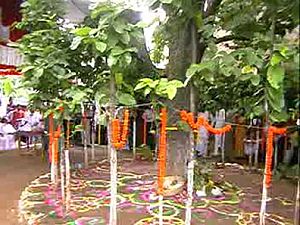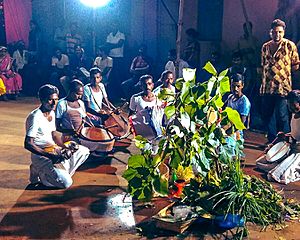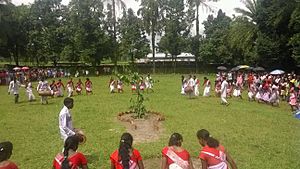Karam festival facts for kids
Quick facts for kids Karam |
|
|---|---|
| Also called | Festival of Harvest |
| Type | Regional Festival/Indian festival |
| Significance | Harvest festival |
| Observances | Jharkhand, Assam, Chhattisgarh, parts of West Bengal, Odisha and Bangladesh |
| Begins | Ekadasi tithi (eleventh day) of lunar fortnight of Bhado |
| Date | August–September |
| Frequency | annual |
Karam is a special harvest festival celebrated in many parts of India, like Jharkhand, West Bengal, Bihar, Madhya Pradesh, Chhattisgarh, Assam, and Odisha, and also in Bangladesh. It's a time when people honor Karam-Devta, who is seen as the god of strength, energy, and youth. People celebrate this festival to thank nature for a good harvest and to wish for good health for everyone.
The festival takes place on the eleventh day of the full moon in the Hindu month of Bhado, which usually falls between August and September. Before the main day, unmarried girls often fast and grow special seedlings for about 7 to 9 days. On the day of the festival, young villagers go into the jungle to gather wood, fruits, and flowers. These items are important for the puja, which is the worship ceremony for the Karam God. During this time, people sing and dance together, filling the air with music and joy. Many different groups of people celebrate Karam, including the Korwa, Sadan, Baiga, Bhumij, Oraon, Kharia, Munda, and others.
Contents
Preparing for Karam Festival
The preparations for the Karam festival usually start about ten to twelve days before the main celebration. This is when nine different types of seeds, such as rice, wheat, and corn, are planted in a basket. This basket of growing seeds is called Jawa. Young girls take special care of these seeds for 7 to 9 days, watching them sprout and grow.
On the morning of the festival, women get busy pounding rice using a traditional wooden tool called a dheki. This rice flour is then used to make a local treat, which can be sweet or salty. This special food is cooked and shared with neighbors and friends, spreading happiness throughout the community.
How Karam is Celebrated
The main ritual involves going to the jungle with drummers and cutting one or more branches from the Karam tree. People worship the tree before cutting its branches. Unmarried young girls often carry these branches back to the village, singing songs in praise of the deity.



Once in the village, the branches are planted in the center of a special area. This area is cleaned with cow-dung and decorated with beautiful flowers. A village priest, known as a Pahan or Dehuri, then performs the worship. The priest offers germinated grains and a traditional festive drink to the deity, asking for wealth and children. Sometimes, a fowl is also offered, and its blood is given to the branch. After this, the priest tells a special story to the villagers about why Karam puja is so important.
After the puja, people wear a yellow bloom behind their ear and begin the traditional dance. The Karam tree branch is washed with milk and a traditional rice drink. Then, it is placed in the middle of the dancing area. After the story of Karam (Nature/God/Goddess) is told, everyone spends the entire night singing and dancing. This lively dance is known as Karam Naach. Women dance to the beat of drums and folk songs called siring. The puja is followed by a community meal and the sharing of a traditional drink called hariya. The next morning, the Karam branch is sprinkled with curd and then respectfully placed into a river.
The festival can be celebrated in two main ways. Sometimes, all the villagers come together on the village street, and they share the costs for the celebration. Other times, a person might host the festival in their own courtyard, inviting everyone to join. Even people who come without an invitation, drawn by the sound of the drums, are welcomed and offered the festive drink.
Why Karam is Important
Karam is a harvest festival, meaning it celebrates the gathering of crops. It also has a very strong connection to nature. People worship trees during this festival because trees are a source of life and help them grow their food. They pray to Mother Nature to keep their farmlands green and to ensure they have plenty of crops. It is believed that this worship helps the seeds grow better and makes the land more fertile.
Karam Devta, the God of power, youth, and energy, is honored during the festival. Those who are celebrating often fast for the whole day and worship the branches of the Karam and Sal trees. Girls also celebrate this festival to strengthen their friendships and sisterhood, often by exchanging a jawa flower.
Stories Behind the Celebration
There are several interesting stories about how the Karam Puja began. These stories are often told to young boys and girls after the rituals are finished.
The Seven Brothers' Story
One popular story tells of seven brothers who worked very hard on their farms. They were so busy that their wives would bring them lunch in the fields every day. One day, their wives didn't bring lunch. When the brothers returned home, they found their wives dancing and singing around a Karam tree branch in the courtyard. One brother became very angry and threw the Karam branch into the river.
Because the Karam deity was insulted, the family's wealth began to disappear, and they became very poor. One day, a priest visited them, and the brothers told him what had happened. The seven brothers then left their village to search for the Karam Rani (Queen). They traveled far and wide until they found the Karam tree. They worshiped it with great devotion, and soon, their family's wealth returned.
The Merchant's Story
Another story is about a rich merchant who returned home after a very successful sea journey. His ship was full of valuable treasures. He waited for his wife and family to welcome him, as was the custom. But it was the day of the Karam festival, and all the women were busy dancing, and the men were playing drums. No one came to greet him.
The merchant became furious. He pulled up the Karam tree and threw it away. Because of this, the Karam Devta became angry, and the merchant's ship immediately sank into the sea. The merchant asked wise people for advice, and they told him he needed to apologize to Karam Devta. He launched another ship and searched for the deity, finding him floating in the sea. He worshiped Karam Devta with great devotion, and all his wealth was restored. Since that day, the annual Karam Puja festival has been held. After dancing and singing all night, people carefully take the branches and place them in nearby rivers or streams.

